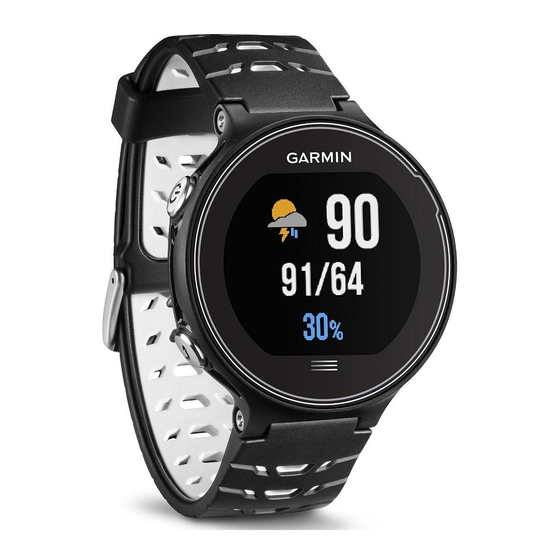Garmin Forerunner 630 Benutzerhandbuch - Seite 19
Blättern Sie online oder laden Sie pdf Benutzerhandbuch für Siehe Garmin Forerunner 630 herunter. Garmin Forerunner 630 24 Seiten.

1
Hold , and select
to turn off the device.
2
While holding
, hold
3
Select
.
Restoring All Default Settings
NOTE: This deletes all user-entered information and activity
history.
You can reset all settings back to the factory default values.
Select
> Settings > System > Restore Defaults >
Viewing Device Information
You can view the unit ID, software version, regulatory
information, and license agreement.
Select
> Settings > System > About.
Updating the Software
Before you can update your device software, you must have a
Garmin Connect account, and you must download the Garmin
Express application.
1
Connect the device to your computer using the USB cable.
When new software is available, Garmin Express sends it to
your device.
2
Follow the on-screen instructions.
3
Do not disconnect your device from the computer during the
update process.
NOTE: If you have already used Garmin Express to set up
your device with Wi‑Fi connectivity, Garmin Connect can
automatically download available software updates to your
device when it connects using Wi‑Fi.
Maximizing Battery Life
• Shorten the backlight timeout
• Shorten the timeout to watch mode
Settings, page
12).
• Turn off activity tracking
• Select the Smart recording interval
page
13).
• Turn off GLONASS
(Changing the GPS Setting, page
• Turn off the Bluetooth wireless feature
Technology, page
5).
• Turn off the Wi‑Fi wireless feature
Wireless Technology, page
Locking the Touchscreen and Keys
You can lock the touchscreen and keys to prevent inadvertent
screen touches and key presses.
1
Select the screen you want to view while the device is locked.
2
Hold
to lock the device.
3
Hold
to unlock the device.
My daily step count does not appear
The daily step count is reset every night at midnight.
If dashes appear instead of your step count, allow the device
to acquire satellite signals and set the time automatically.
Tips for Erratic Heart Rate Data
If the heart rate data is erratic or does not appear, you can try
these tips.
• Reapply water to the electrodes and contact patches (if
applicable).
• Tighten the strap on your chest.
• Warm up for 5 to 10 minutes.
Appendix
to turn on the device.
(Backlight Settings, page
(Power Save Timeout
(Activity Tracking, page
1).
(Data Recording Settings,
(Turning Off Bluetooth
‑ Fi
(Turning Off Wi
5).
• Follow the care instructions
Monitor, page
• Wear a cotton shirt or thoroughly wet both sides of the strap.
Synthetic fabrics that rub or flap against the heart rate
monitor can create static electricity that interferes with heart
rate signals.
• Move away from sources that can interfere with your heart
rate monitor.
Sources of interference may include strong electromagnetic
.
fields, some 2.4 GHz wireless sensors, high-voltage power
lines, electric motors, ovens, microwave ovens, 2.4 GHz
cordless phones, and wireless LAN access points.
Data Fields
Some data fields require ANT+ accessories to display data.
%HRR: The percentage of heart rate reserve (maximum heart
rate minus resting heart rate).
24-Hour Max.: The maximum temperature recorded in the last
24 hours.
24-Hour Min.: The minimum temperature recorded in the last
24 hours.
Average %HRR: The average percentage of heart rate reserve
(maximum heart rate minus resting heart rate) for the current
activity.
Average Cadence: Cycling. The average cadence for the
current activity.
Average Cadence: Running. The average cadence for the
current activity.
Average HR: The average heart rate for the current activity.
13).
Average HR %Max.: The average percentage of maximum
heart rate for the current activity.
Average Lap Time: The average lap time for the current
activity.
Average Pace: The average pace for the current activity.
Average Speed: The average speed for the current activity.
12).
Avg. GCT Bal.: The average ground contact time balance for
the current session.
Avg. Ground Contact Time: The average amount of ground
contact time for the current activity.
Avg. Stride Len.: The average stride length for the current
session.
Avg. Vert. Ratio: The average ratio of vertical oscillation to
stride length for the current session.
Avg. Vertical Oscillation: The average amount of vertical
oscillation for the current activity.
Cadence: Cycling. The number of revolutions of the crank arm.
Your device must be connected to a cadence accessory for
this data to appear.
Cadence: Running. The steps per minute (right and left).
Calories: The amount of total calories burned.
Distance: The distance traveled for the current track or activity.
Elapsed Time: The total time recorded. For example, if you start
the timer and run for 10 minutes, then stop the timer for 5
minutes, then start the timer and run for 20 minutes, your
elapsed time is 35 minutes.
Elevation: The altitude of your current location above or below
sea level.
GCT Balance: The left/right balance of ground contact time
while running.
(Caring for the Heart Rate
14).
Appendix
15
